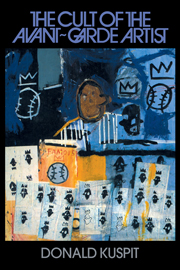Book contents
- Frontmatter
- Contents
- 1 Avant-Garde and Neo-Avant-Garde: From the Pursuit of the Primordial to the Nihilism of Narcissism
- 2 Preliminary Therapeutic Attitude: The Provocative Object as a Path to Primordiality – Picasso and Duchamp
- 3 The Geometrical Cure: Art as a Matter of Principle – Mondrian and Malevich
- 4 The Expressive Cure: Art as the Recovery of Primal Emotion – Expressionism and Surrealism
- 5 Fame as the Cure-All: The Charisma of Cynicism – Andy Warhol
- 6 Enchanting the Disenchanted: The Artist's Last Stand – Joseph Beuys
- 7 The Decadence or Cloning and Coding of the Avant-Garde: Appropriation Art
- Notes
- Index
1 - Avant-Garde and Neo-Avant-Garde: From the Pursuit of the Primordial to the Nihilism of Narcissism
Published online by Cambridge University Press: 05 June 2012
- Frontmatter
- Contents
- 1 Avant-Garde and Neo-Avant-Garde: From the Pursuit of the Primordial to the Nihilism of Narcissism
- 2 Preliminary Therapeutic Attitude: The Provocative Object as a Path to Primordiality – Picasso and Duchamp
- 3 The Geometrical Cure: Art as a Matter of Principle – Mondrian and Malevich
- 4 The Expressive Cure: Art as the Recovery of Primal Emotion – Expressionism and Surrealism
- 5 Fame as the Cure-All: The Charisma of Cynicism – Andy Warhol
- 6 Enchanting the Disenchanted: The Artist's Last Stand – Joseph Beuys
- 7 The Decadence or Cloning and Coding of the Avant-Garde: Appropriation Art
- Notes
- Index
Summary
The Idealization of the Avant-Garde Artist as Transmitter of Value
Do not
frighten me more than you
have to! I must live forever.
Frank O'Hara“Ah! Sir, a boy's being flogged is not so severe as a man's having the hiss of the world against him. Men have a solicitude about fame; and the greater the share they have of it, the more afraid they are of losing it.” I silently asked myself, “Is it possible that the great SAMUEL JOHNSON really entertains any such apprehension, and is not confident that his exalted fame is established upon a foundation never to be shaken?”
James BoswellHow little are genuine artists concerned with their artistic prestige! Their primary concern is not the masterpiece itself, but the ability to create, to remain alive, even when this may often push them down below heights previously reached.
Max FrischThe apotheosis of the avant-garde or modernist artist as the symbol of heroic resistance to all that is oppressive and corrupt in bourgeois civilization, if not as its savior, has been until recently the major way of stating the significance of modern art. So-called postmodernism or neo-avant-garde art is the symbol of its passing, the indication that the idol has feet of clay.
The avant-garde artist is conceived as a kind of Promethean adventurer, an individualist and risk taker in a sheepish society, an Overman bringing to the more timid world of the herdman, to use Friedrich Nietzsche's distinction, a new kind of fire, burning away blinding darkness and affording new insight as well as sight, a new vision of what art as well as life can be – a comprehensive new enlightenment.
- Type
- Chapter
- Information
- The Cult of the Avant-Garde Artist , pp. 1 - 27Publisher: Cambridge University PressPrint publication year: 1993



